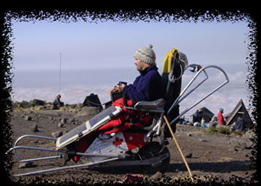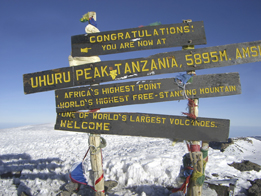Section 2
1. Section 2
1.24. Lesson 3
Section 2: Slope—Rate of Change
Lesson 3: Rate Problems—Imperial and Metric Systems

Corrine Gailloux. Jim Milina: © All rights reserved.
Focus
Have you ever accomplished a goal that you thought was impossible? Imagine climbing a mountain. Now imagine climbing a mountain in a wheelchair! Many people, including Canadian Jim Milina (shown in the photo on the right), have climbed mountains in wheelchairs.

Hemera/Thinkstock
Mount Kilimanjaro is a mountain in Tanzania that Jim Milina climbed in his customized wheelchair with the help of friends and local guides. What reasons can you think of for using a special wheelchair for Jim’s climb?
Mount Kilimanjaro is 5895 m high from sea level to the summit. It is the highest point on the African continent.
Try this question to imagine just how tall this mountain is: If you were standing on each others' shoulders, how many people of the same height as you would it take to be as tall as Mount Kilimanjaro? ![]()
How long do you think it would take to climb Mt. Kilimanjaro? If you knew how long this journey would take, you could then make daily plans for
- how many kilometres you would climb
- how long of a rest you would take
- how much food and water you would need
Lesson Question
- How are tables used to solve rate problems that move between metric and imperial systems?
Assessment
Your assessment for this lesson may include a combination of the following:
- course folder submissions from the Try This and Share sections of the lesson
- your contribution to the Math 20-3: Glossary Terms and the Formula Sheet
- Lesson 3 Assignment (Save a copy of your lesson assignment document to your course folder now.)
- the Project Connection
Materials and Equipment
- calculator
- measuring tape